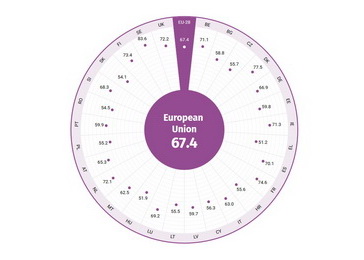 The EU continues its snail’s pace when it comes to gender equality progress. The latest Gender Equality Index from the European Institute for Gender Equality (EIGE) shows that the EU’s score for gender equality is up just one point to 67.4, since the 2017 edition. Sweden continues to top the EU scoreboard, with 83.6 points, followed by Denmark with 77.5. Greece and Hungary have the most ground to make up, with both scoring less than 52. The biggest improver is Portugal, with an increase of 3.9 points, followed closely by Estonia with 3.1 points.
The EU continues its snail’s pace when it comes to gender equality progress. The latest Gender Equality Index from the European Institute for Gender Equality (EIGE) shows that the EU’s score for gender equality is up just one point to 67.4, since the 2017 edition. Sweden continues to top the EU scoreboard, with 83.6 points, followed by Denmark with 77.5. Greece and Hungary have the most ground to make up, with both scoring less than 52. The biggest improver is Portugal, with an increase of 3.9 points, followed closely by Estonia with 3.1 points.
“We are moving in the right direction but we are still far from the finish line. Our Index, which sets a benchmark for gender equality in the EU, shows that almost half of all Member States fall below the 60 point mark. As the new EU Parliament and Commission shape and renew EU priorities for the next strategic framework, it is crucial that gender equality gathers speed,” said Virginija Langbakk, Director of the European Institute for Gender Equality (EIGE).
The lowest scoring domain is power, which looks at equality in decision-making. Yet, it is the area with the biggest progress. This has been mainly driven by the rise of women on company boards, although in just a few Member States. France is the only one to have at least 40 % of each gender on the boards of publicly listed companies.
“Gender inequality is holding Europe back from reaching its full potential. I am proud of what we have achieved, however now our actions need to make a difference on the ground. Our Work-Life Balance Directive adopted this year will be a game-changer for women and men across Europe. The rules will support more equal sharing of caring responsibilities, which will allow women to stay on the labour market and take on challenging roles or management positions,” said Věra Jourová, European Commissioner for Justice, Consumers and Gender Equality.
Focus on work-life balance
Work-life balance and its connection to gender equality is a special focus of this year’s Index. Parental leave is one of the important policy measures to support parents who balance caring duties with work but it is not available to all. In the EU, 28 % of women and 20 % of men are ineligible for parental leave.
Access to affordable and good quality childcare services is important for work-life balance, but it is not only children who need looking after. Ageing and disability rates are rising in the EU, which pushes up demand for long-term care services for older people and people with disabilities. Women of pre-retirement age do the bulk of informal long-term caring in the EU. The difference is remarkable in the 50-64 age group: 21 % of women and 11 % of men care for older people and/or people with disabilities at least several days a week.
As part of the work-life balance analysis, the Index also examined whether women and men have the same opportunities to work flexibly, to attend training courses, to use transport and commute. An important pillar of work-life balance is flexible working arrangements. EIGE’s work-life balance scoreboard presents the different options people have to balance their work and personal life. It shows whether these options are equally available to women and men and it gives new ideas for monitoring the European Pillar of Social Rights and its Work-Life Balance Initiative.
The Gender Equality Index is a tool to measure the progress of gender equality in the EU, developed by the European Institute for Gender Equality (EIGE). The Index has six core domains – work, money, knowledge, time, power and health – and two additional domains: violence against women and intersecting inequalities. It gives more visibility to areas that need improvement and ultimately supports policy makers to design more effective gender equality measures.
The Index also shows the diverse realities that different groups of women and men face. It examines how factors such as disability, age, level of education, country of birth and family type, intersect with gender to create different pathways in people’s lives. For the first time, the Index highlights the situation of LGBTQI+ people and Roma and Muslim women in areas where statistics are available.
Explore the Gender Equality Index 2019.
Source: eige.europa.eu
 Government of the Republic of Serbia
Government of the Republic of Serbia















 pdf [271 KB]
pdf [271 KB]
Leave a Comment